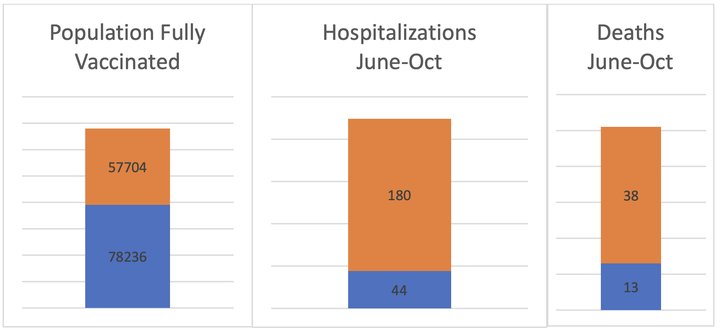Humboldt County Health Officer Dr. Ian Hoffman submitted the following written report to the Board of Supervisors for Tuesday’s meeting.
COVID-19 case rates have continued to drop over the past few weeks which is needed news for our community. The case rates today remain high, however, near where they were during the peaks of the previous surges in winter and spring.
Under the CDPH “Blueprint for a Safer Economy” we would continue to be assigned “Purple Tier” as of today. Based on CDC data tracker website, Humboldt County continues to be in the “Red, High Transmission” tier.
Per CDC guidance, all residents in “Red, High Transmission” tier counties are recommended to mask regardless of vaccination status, and avoid gatherings and crowded places, especially those with risk factors for severe COVID-19 illness or those who are unvaccinated or both.
Hospitalizations remain higher than they were during the peaks of previous winter and spring surges despite the declining case rates. This is due to very high overall cases in this surge.
We will likely continue to see hospitalizations and deaths at these higher rates in coming weeks before they start to decline 2-4 weeks behind the decline in COVID-19 case rates.
The average age for hospitalization in the Delta surge differs among fully vaccinated and unvaccinated groups (57 years of age average for unvaccinated hospitalizations, 75 years of age average for post-vaccine infection hospitalizations). This is also true of deaths based on vaccination status (66 years of age average for unvaccinated deaths, 79 years of age average for post-vaccine infection deaths).
The graphs below illustrate that during the Delta surge the number of hospitalizations and deaths were largely in the unvaccinated despite the fully vaccinated making up a larger percentage of the population. Currently 57% of the county is fully vaccinated. Blue represents fully vaccinated; orange represents unvaccinated populations.

Monoclonal antibody clinics at Saint Joseph’s Hospital in Eureka continue to help mitigate the hospital impact during this surge. The state has extended support for this clinic to continue through the end of November. So far none of those who have become infected with COVID-19 virus and then received monoclonal antibody treatment have been hospitalized. And while this treatment is very effective in the short term at helping protect our hospitals and the individuals who received the treatment, it does not replace vaccination in that the antibody protection afforded by this treatment lasts only a few months.
Vaccine immunity is expected to last for years if not a lifetime, and those who received antibody treatment are recommended to get vaccinated 90 days after the antibody treatment.
Vaccines continue to be the best, safest, most cost-effective protection against COVID-19 disease for our community. Data continues to support that communities with higher vaccination rates have seen less hospital and death burden during the Delta surge even though there are cases in the fully vaccinated. Post-vaccine cases are milder, less likely to spread to close contacts, and are much less [likely] to result in severe disease.
Humboldt County Public Health vaccine clinics are providing Pfizer boosters and Moderna additional doses for immunocompromised, and we are preparing for likely CDC approvals for other boosters, as well as the likely approval for Pfizer for the 5-11 age group. Humboldt County Public Health will continue to support efforts to increase vaccination in our community as it is the best tool to end the pandemic.
With the expansion of Pfizer boosters by CDC approval a few weeks ago we have seen increases in number of boosters given across the county. These boosters help to reduce the hospital and death burden in the fully vaccinated as well as lowering the number of infections in those getting boosters.
Unfortunately, we have also seen a sharp decline in first and second doses in that same time. It is imperative that we as a community continue to increase the number of those who are fully vaccinated, so all efforts towards that goal are encouraged.
There are still around 6% of the population who are only partially vaccinated, and it is important for those folks to complete their vaccination as we know with Delta that partial vaccination is much less effective than it was against prior variants.
Several local organizations, business, venues have taken steps towards requiring vaccination, a step which helps increase the overall rate of vaccination in the community. While boosters will help to reduce some of the COVID-19 impact by reducing hospitalization and death in those at the highest risk, booster will not get us out of the pandemic. Only increasing first and second doses will get us closer to ending the pandemic.
CLICK TO MANAGE